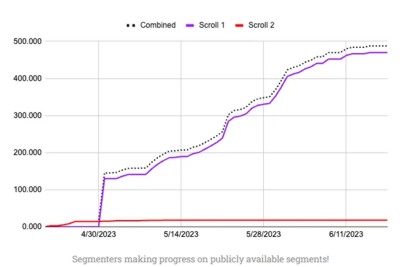| Vesuvius Challenge - Progress and Prizes |
| Written by Sue Gee | |||
| Sunday, 20 August 2023 | |||
|
The Vesuvius Challenge was launched in March 2023 with a Grand Prize of $700,000 for the first team to read at least four passages from a Herculaneum Papyri scroll with a deadline of December 31st, 2023. There was quick uptake by the machine learning and computer vision communities. Here's a progress report with details of the latest prize - for finding letters in a scroll. We first reported on the Vesuvius Challenge in early April, see Can ML Unlock The Secrets of the Herculaneum Scrolls?. It was created by former CEO of GitHub Nat Friedman, venture capitalist Daniel Gross and Dr. Brent Seales, a computer scientist at the University of Kentucky, who in 2015 had "read" the En-Gedi scroll, aka Dead Sea scroll, using X-ray tomography. He and his team then turned their attention to the even more fragile Herculaneum Papyri, and in 2019 started to use a particle accelerator to scan two full scrolls and several fragments. By early 2023 the team's machine learning model had managed to recognize ink from the X-ray scans and had even uncovered some characters in hidden layers of papyrus. Now reduced to a software problem, the next step was to incentivize the machine learning and computer vision researchers to work together by means of an open competition. To get things off the ground, the first round of prizes were "Open Source prizes" to encourage working together and sharing. Three prizes of $2,000 each had been on offer but in the event four prizes of $2,500 were awarded, "to encourage collaboration in the open". Shortly after the open source prizes had been awarded came the announcement of $35,000 in prizes for tools that could perform 3D segmentation of scrolls - i.e identifying sheets of papyrus in a 3D scan of a scroll. The prize money on offer for Scroll Segmentation was later increased in order to award more prizes - two of $10,000 and five of $5,000 and by early June segmenters had nearly achieved 500 cm2. The early spike here is due to Scroll Viewer, one of the winners of the open source prizes. Following the success of the Segmentation Tooling Prize, a second round was announced, running from August 28th to September 15th with prizes being awarded to models that make it easier and faster to segment the scrolls, with the ultimate goal of fully mapping both scrolls. Three prizes of $10,000 and two of $5,000 will be weighted towards submission that help segment large or hard segments and which are actually used by segmenters with the rubric highlighting:
The Ink Detection Challenge, with $100,000 in prizes, ran for 3 months from March 15. The task was to detect ink from 3D X-ray scans of scrolls and read the contents.The dataset contained four fragments at 4µm resolution, made using a particle accelerator, as well as infrared photographs of the surface of the fragments showing visible ink which had been aligned with the x-ray scans. Hand-labeled binary masks indicating the presence of ink in the photographs, were also provided. Hosted on Kaggle, 1,249 teams took part in this challenge and it resulted in 10 open source solutions to the ink detection problem and hopefully a higher probability that one of the solutions can scale to a full scroll and also led to the Ink Detection Followup Prize. This is currently underway with a deadline of August 28th and prize pool of $12,000. Recently the secret 4th fragment that was used for verification in the Ink Detection Prize has been released on the data server and can now be used to fully reproduce the results of that prize, as well as train new models on.
Another $50,000 in prizes was announced in May as the First Letters Open Source Prize: The purpose of this prize is to close the gap between the Ink Detection Prize on Kaggle, and the much more difficult Grand Prize. We’ll learn a lot from this: what segmentation and flattening techniques work best; what ink detection methods work well in the full scrolls, and other things we can’t predict now. $40,000 will be awarded to the first team that uncovers 10 letters within a single area of 4cm2 from Scroll 1 or 2, and open sources their methods and results (after winning the prize). There is also $10,000 prize for the second team to reach this milestone. The progress made by the Vesuvius Challenge since its launch in March certainly vindicates the idea of organizing an open competition for solving what had been an intractable problem. More Information$50,000 Segmentation Tooling 2 Related ArticlesCan ML Unlock The Secrets of the Herculaneum Scrolls? To be informed about new articles on I Programmer, sign up for our weekly newsletter, subscribe to the RSS feed and follow us on Twitter, Facebook or Linkedin.
Comments
or email your comment to: comments@i-programmer.info
|
|||
| Last Updated ( Sunday, 20 August 2023 ) |




